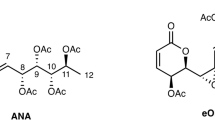Abstract
Extracts of the plant Aconitum spec. are used in traditional Chinese medicine predominantly as anti-inflammatory and analgesic agents, the latter allegedly equally potent as morphine but without any habit-forming potential. As the only pharmacologically active compounds, the C19 diterpenoid alkaloid aconitine, and some of its derivatives, have been proven to be antinociceptive in different analgesic assays, but the mode of action is unknown. To elucidate the mode of action, ten aconitine-like derivatives were investigated with respect to their affinity for voltage-dependent Na+ channels, the action on synaptosomal Na+ and Ca2+ homoeostasis and their antinociceptive, arrhythmogenic and acute toxic properties. Since aconitine is known to bind to site II of Na+ channels, we determined the affinity of the aconitine-like derivatives in vitro to synaptosomal membranes by the [3H]-batrachotoxinin-binding assay and their properties on intrasynaptosomal concentrations of free Na+ and Ca2+ ([Na+]i and [Ca2+]i), both the latter determined fluorometrically with SBFI and Fura-2 respectively. Furthermore, the alkaloids’ arrhythmogenic potential was investigated in guinea-pig isolated atria and the antinociceptive action on formalin-induced hyperalgesia and the acute toxic action estimated in mice. The results show that the alkaloids could be divided into at least three groups. The first is characterized by a high affinity to the site II of Na+ channels (K i about 1.2 μM), the ability to enhance [Na+]i and [Ca2+]i (EC50 about 3 μM), a strong arrhythmogenic action that starts at about 30 nM, an antinociceptive effect (ED50 about 0.06 mg/kg) and high acute toxicity (LD50 values about 0.15 mg/kg). To this group belong aconitine, 3-acetylaconitine and hypaconitine. The second group, with lappaconitine as the only member, has an affinity to Na+ channels an order of magnitude lower (K i = 11.5 μM), less acute toxicity (LD50 about 5 mg/kg), and a two orders of magnitude lower antinociceptive action (ED50 about 2.8 mg/kg) and lower cardiotoxicity (bradycardia observed at 3 μM). Additionally, lappaconitine suppresses the increase in [Ca2+]i of aconitine-stimulated synaptosomes and increases the excitation threshold of left atria, indicating an inhibition of Na+ channels. The other derivatives, i.e. delcorine, desoxydelcorine, karakoline, lappaconidine, lappaconine and lycoctonine, belong to the third group, which has hardly any effects. They have a low affinity to Na+ channels with K i values in the millimolar range, show no effect on synaptosomal [Na+]i and [Ca2+]i, no arrhythmogenic potential up to 100 μM, no antinociceptive activity and low toxicity with LD50 values greater than 50 mg/kg. For the investigated alkaloids we suggest two different antinociceptive-like modes of action. Aconitine, hypaconitine and 3-acetylaconitine may induce a block of neuronal conduction by a permanent cell depolarisation, whereas lappaconitine might act like local anaesthetics. However, because of the low LD50/ED30 quotients of 2–6, the antinociceptive-like action of the Aconitum alkaloids seems to reflect severe intoxication rather than a specific antinociceptive action. The structure/activity relationship shows that alkaloids that activate or block Na+ channels have a benzoyl ester side chain in the C-14 or C-4 positions respectively, whereas the other compounds lack this group.
Similar content being viewed by others
Author information
Authors and Affiliations
Additional information
Received: 24 June 1997 / Accepted: 8 September 1997
Rights and permissions
About this article
Cite this article
Gutser, U., Friese, J., Heubach, J. et al. Mode of antinociceptive and toxic action of alkaloids of Aconitum spec.. Naunyn-Schmiedeberg's Arch Pharmacol 357, 39–48 (1997). https://doi.org/10.1007/PL00005136
Issue Date:
DOI: https://doi.org/10.1007/PL00005136




